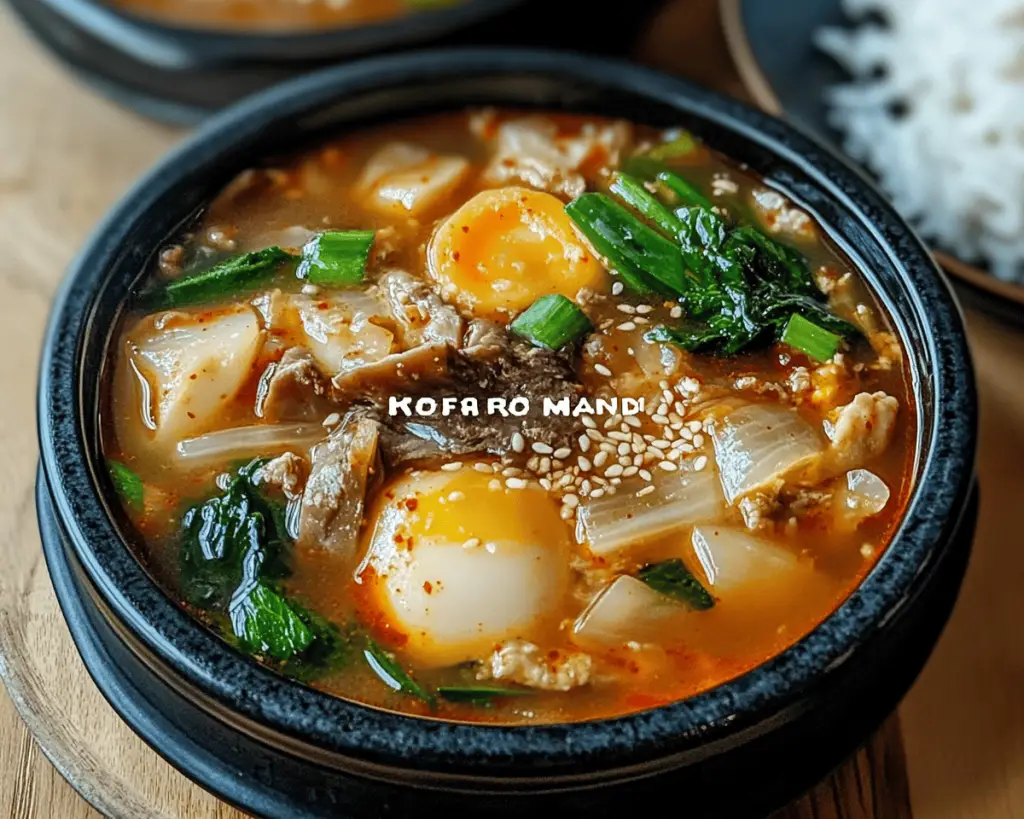The first chill of winter has crept into my heart. It’s the kind of cold that nestles deep into your bones, making you crave warmth—be it from a cozy blanket or something simmering on the stove. There is a soft magic in winter, a whisper of nostalgia tugging at me whenever I feel the frost touch the window panes. As I approach the end of the year, I find myself bathed in memories of my grandmother and the laughter-filled evenings we spent in her kitchen, preparing bowls of bubbling soups that became staples of our family gatherings.
Soup in its many forms has always been a source of comfort for me. The aroma wafting through the air, the steam rising gently as it escapes the pot—each moment feels like an invitation to settle down, to connect, and to merely be. And in these colder months, nothing quite compares to a humble bowl of **Korean Winter Soup**, or what we lovingly refer to as **Tteokuk**. This dish, rich with tender rice cakes, savory broth, and a touch of spice, is like a warm hug on a dreary day. It’s packed with interlaced memories and the very essence of winter warmth.
I can still hear my grandmother humming as she worked, her hands deftly slicing vegetables. The rhythmic sound of a knife against the cutting board played the background music to our kitchen symphonies. My role would often be to taste—just a little pinch of this, a small spoonful of that. In her hands, the ordinary transformed into something extraordinary. Making Tteokuk carried a particular significance; each bowl served as a celebration of another lunar year come to pass, a means of inviting good fortune into our lives.
As I embrace the gentle winter months, I draw on her teachings and love as I cook this simple yet profound dish. Perhaps it’s the intrinsic connection to our roots that fills this soup with flavor, or maybe it’s simply how each ingredient tells a story. The cabbage brings the crunch, the mushrooms add an earthy depth, and the rice cakes float around like little delights, ready to soak up the broth.
### Behind Every Ingredient
Beef broth – My grandmother always insisted on using beef bones, cooking them for hours to extract their deep, rich flavor. It transforms a simple soup into a luxurious experience. I remember her looking at me over the steaming pot, explaining how each bubble that surfaced was nutrition just waiting for us, patiently extracted by the heat and time. The deep umami takes me back to winter nights, warms me inside out.
Rice cakes (Tteok) – These little morsels are more than just a texture; they carry the essence of celebration in Korean culture. As a child, I would eagerly wait for the chewy texture to greet my palate, catching the little bits of comfort and tradition in each bite. My grandmother would tell me stories of how rice cakes symbolize prosperity and happiness. She would say, “Every slice brings new beginnings, my dear,” and I’ve taken that sentiment into adulthood.
Cabbage – The addition of cabbage provides both crunch and sweetness. There were many moments spent in my grandmother’s garden, heads of cabbage swaying gently in the breeze, tendrils of fresh earth melding with the sweet aroma of the leaves. When I slice into it now, the scent brings back memories of her teaching me about planting and patience.
Garlic – Garlic is a tradition in my family. Not only does it add flavor, but the act of crushing garlic is cathartic, rhythmic. The press of the knife is a small release, each clove falling away like the worries I try to let go of. The fragrant aroma fills the kitchen like her sweet laugh, brightening an already vibrant atmosphere.
Green onions – An essential garnish, green onions lend a fresh, peppery note. Their vibrant green color always felt like hope, a reminder that growth comes from the coldest of winters. They were often planted with my grandmother, and each spring they returned, just like the promise of brighter days.
Sesame oil – I find myself loving the warmth that this oil brings. Its nutty aroma is both grounding and somehow light. It reminds me of times spent gathered around the table, where laughter filled the air and stories were exchanged over small bowls of rice and fragrant dishes.
### Comfort Meets Care: Is It Healthy?
When I think about nourishment, I realize that Tteokuk is beautifully balanced, a testament to the harmony of traditional Korean cooking. The ingredients reflect a care for the body as much as the soul. The beef broth is hearty yet cleansing, a source of collagen rich in goodness, supporting joints during these cold months. The cabbage punctuates the dish with vitamins and fiber, inviting health and vitality.
Yet a soup can offer indulgence too, and I embrace that wholeheartedly. Each sliver of rice cake is comforting, both in its chewy texture and blank canvas nature, absorbing the richness of its surroundings. While I rejoice in its flavors, I am also aware that too much indulgence can weigh heavily on my conscience, so I cherish the layers of flavors while reminding myself to enjoy in moderation.
This soup is nourishing not only to the body but also to the spirit. As I thoughtfully stir the pot, I feel a sense of balance—a mixture of hearty and delicate, seasoned and sweet—in each bubbling spoonful, an allegory for life itself. It reminds me to embrace the changes of the year, allowing myself to reflect and grow, bringing with it a touch of comfort for the soul.
### Ingredients for Korean Winter Soup
– 6 cups homemade or store-bought beef broth
– 1 cup sliced beef, preferably brisket or chuck
– 3 cups water
– 2 cups sliced rice cakes
– 2 cups chopped cabbage
– 1 cup sliced shiitake mushrooms (or any mushrooms you prefer)
– 3 to 4 cloves minced garlic
– 2 green onions, thinly sliced
– 1 tablespoon sesame oil
– Salt and pepper to taste
– Optional: 2 eggs, beaten (for garnish)
### Here’s How I Make It
1. **Starting the Base**
As the winter sun hangs low in the sky, I pull out my biggest pot—the one that has scratches from years of loving use—and pour in the rich, fragrant beef broth. I can almost hear my grandmother’s voice guiding me, reminding me to allow the broth to warm slowly over medium heat. I feel a tingle of anticipation as the steam rises, wrapping around me like a gentle embrace.
2. **Beef and Garlic**
While the broth simmers, I slice the beef into thin strips, recalling how my grandmother would demonstrate this with such elegance. I toss them into the pot and follow up with a generous amount of minced garlic. The smell of garlicky beef envelops me, as it begins to render down into the broth. It’s the kind of aroma that flirts with my memory, making me smile.
3. **Veggies Farewell**
Next, I add in the chopped cabbage and mushrooms. The vibrant splash of greens creates a lively contrast against the dark broth—a visual feast. I give it a gentle stir, watching the vegetables dance against the bubbles bursting at the surface. Their earthy scent mingles beautifully with the hearty broth, and I feel an overwhelming sense of gratitude for this simple gift from nature.
4. **Rice Cakes Appear**
With a soft splash, in go the rice cakes. They plump up gently as they absorb all the flavors of the broth, growing tender and chewy, much like the stories infused in each meal. I love keeping my kitchen tranquil while the soup bubbles away, allowing myself to reflect. During this time, I think of the essence of winter, the solitude it brings, and how food can deeply connect us to one another.
5. **The Finishing Touches**
After about 20 minutes—when the rice cakes have softened and all the flavors have married together—it’s time to introduce a drizzle of sesame oil. Its rich, nutty aroma envelops the soup, and I feel a heartwarming contentment settle in my chest. I taste a spoonful, adjusting the salt and pepper to my liking, and I may or may not let out a soft sigh; this moment is deliciously gratifying.
6. **Garnishing Joy**
As the soup is nearing completion, I whisk up a little egg and pour it in a steady stream, stirring gently to create ribbons of custard within the broth. Finally, I sprinkle in the green onions for a pop of color and freshness. As I ladle the soup into warm bowls, the winter light casts a beautiful glow, and I find joy in the simplicity.
### My Little Secrets
There are a few little rituals I’ve cultivated over the years. One that I cherish is serving this soup in my grandmother’s bright blue ceramic bowls—every slosh of the spoon reminds me of the laughter and warmth that filled her home.
I sometimes like to add a hint of spice, perhaps a sprinkle of gochugaru (Korean chili flakes), to awaken the senses even further—an unexpected dimension of depth and heat against the warm backdrop of winter.
Another trick I enjoy is to keep back just a few rice cakes each time I make Tteokuk, storing them to surprise myself later. There’s a simple joy in cooking again with this dish, uncovering the flavors of a joyful moment.
### Closing Thoughts
As the last remnants of soup disappear from my bowl, I find myself enveloped in a cocoon of warmth filled with memories. I think about my grandmother and how she lovingly nurtured me through cooking, instilling lessons about patience, simplicity, and family in ways that words never could.
Food transcends generations, weaving stories into the fabric of our lives, connecting us to moments and people, far beyond the meal itself. This Korean Winter Soup—simple yet profound—is a vessel of connection, a recipe to share and celebrate, nourishing the body and spirit alike amidst the winter chill. The echoes of laughter and warmth remain; each spoonful quite literally shines with the glow of my past, and in that, I find true joy. Let this winter, and every winter to come, be adorned with the love that lives in our kitchens, for such is the heart of home.



